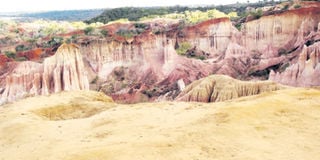In Hell’s Kitchen

What you need to know:
- If you think the landscape at Marafa is magnificent, wait until you see the sunset amidst a blaze of colours. And after dusk, the moon casts a silver light in the depression giving it the appearance of a stage with the most stunning silver layer stacked against different hues of bronze and copper.
It is mid-morning in Dakatcha Woodland, a forest deep in the heartland of Malindi, and Albert Baya, a guide from Arabuko-Sokoke forest is driving us to Nyari Bore, a place where the earth’s surface is eroded into the most breathtaking depression you’ll ever see.
In fact there are several nyari (depressions) in Dakatcha Woodland, with the most famous being Hell’s Kitchen in Marafa.
“Bore means the place of uneven water,” says one of the guides, as we drive along.
It is almost impossible to believe that something as bad as erosion could produce such a beautiful natural wonder, and since the nyari are best experienced through guided walks, soon we are out and about on the chalky multi-coloured rocks.
One of the guides, Julius Mwambire spots the trail of a golden-rumped sengi (elephant shrew) that suddenly dips into nothingness at the end. From the edge of the outcrop that we are standing on I see sandstone pillars in various shapes and sizes and in the distance, Mwangea Hill, the highest point in Kilifi County, stands tall.
Once filled with a cache of rare plants, the hill is now a cultivated maze of farms and houses. Mwambire, a former cook in Malindi and now full-time conservationist, takes charge of our meals. We are having breakfast – mandazi washed down with hot tea – now, after an early-morning trek along Deke River searching for Fischer’s turaco.
Fleur Ng’weno – the doyen of everything wild – shooed us along for an early morning bird walk along the river near Marafa. It was barely sunrise but the bumpy ride on the murram roads, which see little traffic save for motor bikes ferrying customers between villages, jolted us awake.
Birding hotspot
The river is a mere trickle in a deep ravine but it is a hotspot for Fischer’s turaco and other birds. Climbing down the steep river bank, Samson Katisho and Julius Mwambire of Dakatcha Woodland Conservation Group (DWCG) led the way to the bird responsible for our early morning walk.
There were chirping birds everywhere and we heard the green wood-hoopoe long before we saw them, of course with the help of Japhet Garama of Baricho Hot News, who identifies every bird by sound: African green pigeon, trumpeter hornbill, chestnut-fronted helmet-shrike, brown-breasted barbet and the very regal lizard buzzard.
The last three appear in colour in the must-have Checklist of the Birds of Dakatcha Woodland published by Nature Kenya and its partners. There was excitement when the gorgeous Fischer’s turaco made an appearance.
Masterpiece
Looking through binoculars, I marveled at the foot-long bird on the enormous fig tree. It looked like a masterpiece created with great care. The lone bird was soon joined by the rest of the flock – eight in all, their red wingtips breaking the monotony of the green undertones of the forest.
Alongside the birds, we saw white-spun nests and butterflies in their resplendent colours. Satisfied, we left the river and headed to Nyari Bore for a well-deserved breakfast.
Later, we drove to Marafa and got there just before dusk. A lone baboon cut a silhouette atop a natural column in Hell’s Kitchen, the most visited of the depressions of Dakatcha Woodland.
“The depressions were formed by soil erosion over thousands of years and the erosion is still ongoing,” Mwambire, our guide, explained. “The sand stone is very loose and easily eroded by rain water and every five to ten years the walking trails move with the changes.”
Mwambire pointed at the natural sculptures in the pit – the rhino head, the cathedral, and the elephant head. Many years ago, the locals painted their bodies with the multi-coloured earth.
Giriama legend has it that Hell’s Kitchen (the Marafa depression) was formed as a result of God’s punishment towards a rich and extravagant family, who once dared to bathe in milk while everyone else was starving.
God was so angry, that he sent a flood that killed that family by opening the ground beneath them – this is how the depression was formed. The white and red stone are said to be milk and blood, black rocks signify the people, purple, their clothes and brown, the earth.
If you think the landscape at Marafa is magnificent, wait until you see the sunset amidst a blaze of colours. And after dusk, the moon casts a silver light in the depression giving it the appearance of a stage with the most stunning silver layer stacked against different hues of bronze and copper.
This is a perfect backdrop to propose marriage to your partner don’t you agree?
Useful contacts:
Julius Mwambire 0725 082 464
In Watamu, Arabuko Sokoke Forest Guides Association through Jonathan Mwachongo: [email protected]
Or Spinetail Safaris through Albert Baya: [email protected]




